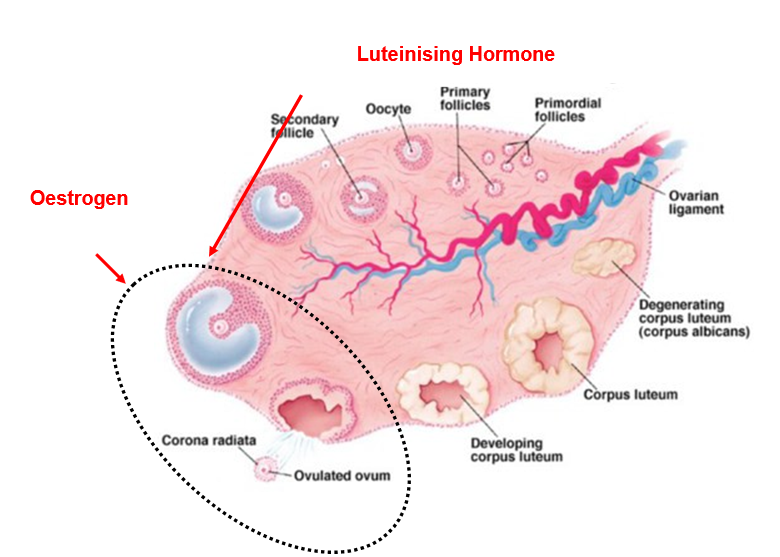Flush feeding of the Sow
Flush feeding occurs during the weaning to oestrus interval (WEI). This is from the moment the sows are weaned to the point of service (insemination). During this time, it is advised to feed a flush diet at an increased feeding level. The flush diet contains higher levels of starch and sugars to stimulate the production of insulin and the insulin peak, thus stimulating the ovaries leading to oestrus. There is a definite advantage to feeding a flush diet!

What is Flush Feeding?
Flush feeding is when the sow is fed a higher-energy diet until she returns to heat. During this period, a sow should consume at least 15kg of flush feed. If flush feed is unavailable or not used, a normal gestation diet can be fed with sugars (glucose & dextrose) top-dressed over the feed at 150gr per feeding. Some products on the market can be included in gestation diets, which serve the same purpose. During this period, sows should not be fed ad libitum. Feed should be allocated in 3 or 4 meals per day, and the sow should be stimulated to eat as much as possible of the total feed allocation.
A typical flush feeding schedule:
|
Days of feeding |
Kg |
|
Day of Weaning (Flush Feed or Alternative) |
3.0 |
|
1 day after weaning |
4.0 |
|
2 days after weaning |
3.5 |
|
3 days after weaning |
3.0 |
|
4 days after weaning |
2.5 |
|
Day of insemination |
2.0 |
The amount of feed consumed during this period will determine the number and quality of ovulated eggs. If more feed is given, the chances of more egg cells of better quality being produced are improved. This leads to increasing the chances of more piglets being born.
Weaning to Oestrus Interval (WEI)

The WEI is, on average, 5 days but can range between 4-6 days. Sows’ udders should be dried up on the 2nd day after weaning. Sows also need to recover body reserves and come back to a positive energy balance. By feeding them a carbohydrate-rich diet, we can decrease the days of oestrus. The weaning to oestrus interval needs to be short (5 days), showing good signs of fertility. Sows only showing heat from the 6th day onwards have lower fertility, and retaining them in the herd needs to be reconsidered. Give the sows enough boar stimulation, fresh feed, and fresh water and make sure their environment is comfortable. If this is done correctly, most sows will already be inseminated on the 5th day. Take care of the sow during the weaning to oestrus interval, and she will reward you with a larger and heavier litter.
How does Flush Feeding help get the sow back into oestrus?
With flush feeding, the stimulation of hormones in the sow (Figure 1) will help get her back on heat. This is through the increased levels of starches and sugars, which causes the insulin peak. Insulin stimulates the hormones to produce more Follicle Stimulating Hormone (FSH) and Luteinizing Hormone (LH). Follicle Stimulating Hormone regulates the follicles and causes an increase in pulse frequency from Luteinizing Hormone, which makes the follicles grow bigger. Well-developed follicles produce more oestradiol (oestrogen). Oestrogen, along with LH, further stimulate the follicles to become dominant and mature. Oestradiol leads to the expression of oestrus through the stimulation of the ovaries and the growth of the follicles. Enhancing the oocyte quality at ovulation.
Flush feeding is important for stimulating the reproductive hormones.

Figure 1: Hormonal changes during weaning to oestrus interval

Figure 2: Luteinising Hormone (LH) and Oestrogen stimulate the follicles to mature
Luteinizing Hormone & Oestrogen cause the follicles to mature, as shown in Figure 2. When the dominant follicles rupture, oocytes are released from the ovaries, and ovulation has begun.
Importance of good follicular development
The follicular development is critical to the reproduction of the sow. This is directly influenced by the metabolic and hormonal status of the sow during late lactation and weaning. During oestrus, the size of the follicle in the ovaries will indicate whether the sow was in a negative or a positive energy balance. Sows that are weaned in a negative energy balance will take longer to return to oestrus, have a longer weaning to oestrus interval and a decrease in farrowing rate, uniformity, and litter size. Sows need to produce well-developed follicles, which can grow and mature.
A negative energy balance contributes to the follicles being smaller and not as well developed. The consequence of poor follicle development is:
- insufficient oocyte development
- Lower progesterone synthesis
- delayed oestrus and signs of oestrus
- longer WEI (>6 days)
- Inadequate corpus luteum development
- variation in early embryonic development
- decrease litter uniformity at farrowing
- Higher embryonic Death
- decrease in litter size at birth
To achieve good follicular development, feed a high-quality diet!!
Management to help assist with Flush Feeding:
During the Weaning to Oestrus Interval, it is very important to make sure that sows are kept as close to comfort as possible. As soon as they enter the mating crates after weaning, ensure that the house is already prepared and clean! Settings should all be correctly set and checked. Sows prefer cooler rooms with temperatures of 22°C. There should be enough good quality water available, at least 2.5L per minute. Feeders should be cleaned regularly, and sows should be encouraged to eat often and enough.
Giving fresh feed multiple times a day and making sows stand up will also encourage them to eat and drink more water, which will, in turn, increase the feed intake. Ventilation should
be set to optimal conditions, and there should be no draught, but there must be enough fresh air coming into the house. Following a light regime with the right light intensity and height above the sow can also assist.
Sow stimulation is very important! Make sure that your sows are not close to your boars or housed in the same house as pregnant sows. Boars should have good qualities that draw the attention of the sows (energetic, aggressiveness, a lot of saliva secretion, good talking abilities). There should at least be nose-to-nose contact.
By doing this and limiting stress on the sows, you give them a good chance to come on heat on time.
Benefits/Advantages to feeding a flush feed:
- Increase in litter size – more follicles being released
- Increase in birth weight of piglets
- Decrease the number of days until the sow returns to heat (decrease the number of days in the mating crate)
- Increase in sow feed intake
- Increase in energy intake
- Sow comes back into a positive energy balance after lactation
- Increasing farrowing rate
There are a lot of factors that have an impact on the weaning to oestrus interval that could influence the fertility of the sows and affect your production. Feeding a high-quality, well-balanced flush feed to sows directly after weaning will stimulate the reproductive hormones to get sows back into oestrus.
For more info on references for the article or any questions, please contact your nearest technical advisor - https://www.deheus.co.za/meet-our-team.
